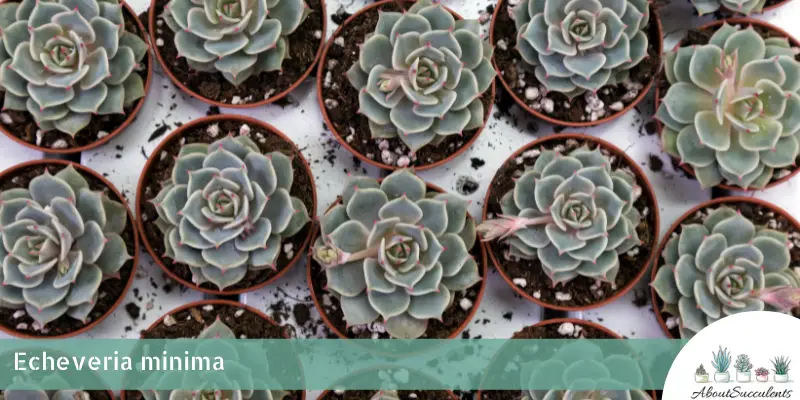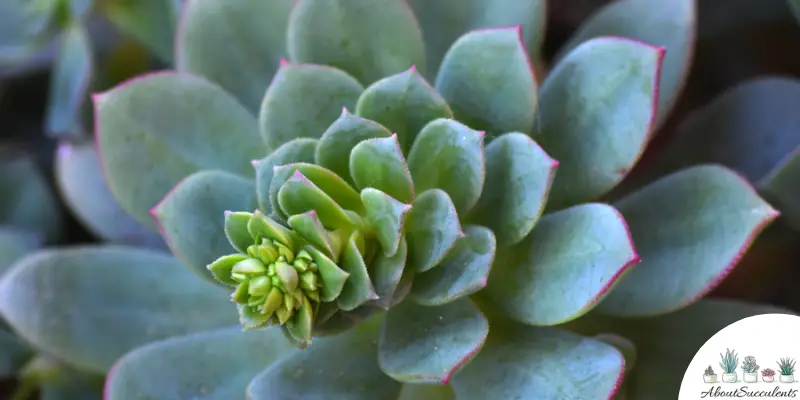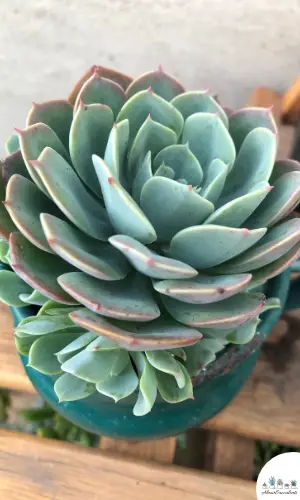
Echeveria minima is an adorable succulent that’s cherished by horticulturists for its fleshy, plump, grayish-green colored leaves that form a densely-packed rosette. The leaves are characterized by well-defined points that develop a coral pink to reddish color when given regular exposure to full sunlight.
As the plant matures, it grows multiple rosettes that clump together and form a succulent so compact you’ll only see the outer halves of the fascinating-looking leaves. In the springtime, Echeveria minima will reward you with yellow-colored, bell-shaped flowers.
Also known by its common name, Miniature Echeveria, this succulent grows to a height of 3 to 5-inches (8 to 13cm) tall. Miniature Echeveria is native to Mexico and is a member of the Crassulaceae family.
General Information
Also known as: Miniature Echeveria
Plant Family: Crassulaceae
Origin: Mexico
Height: 3 to 5-inches (8 to 13cm)
Exposure: Partial to full sun for up to 6 hours every day.
Water Needs: Give the soil a thorough drenching only if you’ve confirmed that it’s completely dry.
Soil Type: Succulent soil mix or cactus mix combined with perlite, pumice, coarse sand, and lava rocks to speed up drainage.
Soil pH: 5.6 to 7.8
How to Grow and Care for Echeveria Minima

Echeveria minima will be an absolute joy to behold in your outdoor succulent garden or patio. The alluring succulent plant will turn any room in your home from so-so to dynamic, especially when positioned in front of a white wall where its full colors will get magnified.
The best part of choosing Miniature Echeveria is that it’s very easy to grow and care for even a beginner garden enthusiast will find immediate success.
One thing you have to remember is that like other species of Echeveria, minima isn’t cold-hardy. If you live in a region which experiences frosty winters or where temperatures fall below 20° F (-6.7° C), it would be best to plant Miniature Echeveria in a container that can be moved indoors.
Other than that, you won’t have to worry about growing Echeveria minima in your garden or inside your home.
Sunlight
As an outdoor succulent, plant Echeveria minima in a location that gets partial to full sunlight for up to 6 hours per day. For the leaves’ edges to develop that tantalizing reddish to coral-pink color, direct sunlight is best for Echeveria minima.
To be more precise, direct morning sunlight. Don’t expose Miniature Echeveria to the scorching rays of the afternoon sun as these can burn the plant’s treasured green leaves.
If you decide that Echeveria minima is ideal as a home ornament, just make sure the pot is situated near a window that receives indirect sunlight for at least 4 hours every day. Get a Grow Light and place Miniature Echeveria under it if your home doesn’t have locations that can assure the consistent availability of sunlight.
Sunlight is very important for succulents to thrive because they need it to produce food. Without sunlight, the plant will suffer from etiolation whereby the leaves stretch out and wither.
Water

Succulents cannot survive if the soil is kept moist for an extended period. Unless the soil dries out quickly, it can quickly grow molds and bacteria. Likewise, excess water will cause the plant’s roots to burst leaving it exposed to fungal infection.
When it comes to Echeveria minima, only water the soil after you’ve tested and confirmed that it’s 100% dry. An ergometer, a tool that measures the level of moisture in the air will be helpful, but a stick will do the job.
Insert the stick an inch into the soil. If the stick feels dry to the touch when you pull it out, that means the soil is ready to get flooded.
Always water the soil and never the plant. Give the soil a thorough soaking. It must be totally drenched in water. If you’re watering potted Echeveria minima, you can stop watering the soil if you see excess amounts coming out of the drain hole.
You’ll water the soil less frequently during the winter months because it will retain moisture longer.
Pot and Soil
Drainage should be the top priority when choosing the ideal types of pot and soil for Echeveria minima.
Unglazed ceramic and terracotta pots are your best choices because these materials allow moisture to leave the soil rather quickly. Choose a pot size that’s slightly bigger than the base of Echeveria minima to give the roots space to grow.
It’s also important to make sure that the bottom of the pot has a drain hole to filter out excess water.
The best soil for Miniature Echeveria is a fast-draining variety such as Cactus or any commercial succulent blend. Add perlite, pumice, coarse sand, or lava rocks to further improve drainage.
How to Propagate Echeveria Minima
Perhaps you’re thinking of giving your office mates Echeveria minima to place on their desks or at their shelves at home. The good news is that Echeveria minima is easy to propagate provided you follow the steps outlined below.
Leaves Cutting Method
Step 1: Choose a healthy leaf and perform a smooth twist and pull action to remove it from the stem. If a part of the leaf remains on the stem, you’ll have to do another one because propagation won’t be successful.
Step 2: Place the leaf cuttings in a dry area and let them harden with calluses. This process might take 2 to 4 days.
Step 3: Once the calluses have formed, place the dried-out leaf cuttings on a pot filled with fast-draining soil.
Step 4: Position the pot near a window that gets morning sunlight and lightly water the soil.
Step 5: Check if the roots have formed. If the roots have taken hold, only water the soil when it’s completely dry.
Offsets Method
Step 1: Gently pull out the offsets that are growing near the base of the mother plant.
Step 2: Leave the offsets in a dry area for 2 to 4 days or until they develop calluses.
Step 3: Plant the callused offsets in well-draining soil.
Step 4: Moisten the soil with a little water and place the pot near a window that gets partial sunlight.
Step 5: Once the roots start forming, only water the soil when it’s 100% dry.
Frequently Asked Questions
Is Echeveria Minima Toxic For Cats And Dogs?
Echeveria minima does not appear on the list of plants toxic to cats and dogs that can be found on the website of the American Society for the Prevention of Cruelty to Animals (ASPCA).
Why Is My Echeveria Minima Dying?
Echeveria minima is a healthy and durable succulent that can endure drought conditions. Like other succulents, it’s vulnerable to root rot and fungal infection. If the illness isn’t attended to right away, your succulent could die.
Overwatering
If your succulent is developing yellowish, unhealthy-looking spots on its vibrant green leaves, this is a sign that a fungal infection is taking place inside the plant. The primary cause of infection contaminating Echeveria is root rot due to overwatering.
When you see these spots on Miniature Echeveria, act right away. Get a knife or garden shears. Make sure these are sharp and sterilized with 70% isopropyl alcohol.
Cut off all of the infected sections of the plant and sterilize the knife or scissors right after. This is done to prevent the infection from spreading.
Remove Miniature Echeveria from the soil and cut off all of the infected roots. Let the plant rest and recover in a dry area while you prepare a new pot with fresh cactus or succulent soil mix.
Replant Echeveria miniature and remember to water the soil after you’ve confirmed its state of dryness.
Yes, you should use a new pot because even if you wash down its former container, traces of the bacteria might still linger.
Pest Infestation
Pests such as mealybugs, spider mites, aphids, and soil gnats love Echeveria minima for its sap. You have to protect Echeveria minima from pests because they’ll drain it of sap and leave substances that can cause fungal infection.
Spray Miniature Echeveria with a natural insecticide like neem oil to keep pests away.
Yes, Echeveria minima blooms yellow-colored and bell-shaped flowers in the springtime.
Last Updated on June 9, 2022 by Sofia Lara